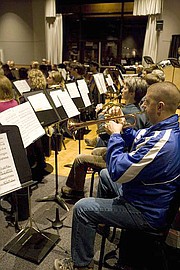'Sounds of magic' closes Cd'A Symphony's 40th season
One year ago, Jan Pellant led the Coeur d’Alene Symphony for the first time as a candidate for the artistic director position. Join the Symphony for this grand finale of Maestro Pellant’s first season.
Beginning with one of the most familiar pieces in western culture, Dukas’ “The Sorcerer’s Apprentice” was introduced to millions through Mickey Mouse’s antics in “Fantasia.” You remember the brooms with buckets of water? This music sets the tone for the concert.
Next, saxophonist Sheila McCallum will perform the Glazunov concerto with the symphony strings. McCallum has played oboe with the Symphony for many years, but her first love was the saxophone. After graduating from San Jose State University, she joined the Air Force Band and played saxophone and flute all over the U.S. and Europe. This concerto is one of the first pieces written for the saxophone as a classical instrument, and Glazunov takes full advantage of the full, rich tones of the solo instrument, both in the lyrical passages and virtuosic cadenzas.
The final piece on the program is the “Pines of Rome,” by Ottorino Respighi. The piece loosely depicts pine trees in four different locations in Rome throughout the day. “The Pines of Villa Borghese,” the first movement, is playful and evokes children in a garden. “The Pines Near a Catacomb” is majestic, but dark and shadowy, with a dirge-like motif played by the lower instruments juxtaposed against a hymn. “The Pines of the Janiculum” is set as a nocturne in front of the temple of Janus. The flute mimics a nightingale as this piece flows directly into “The Pines of the Appian Way.”
This movement begins with haunting echoes of military marching slowly approaching. Solos by various wind instruments evoke visions of the oncoming masses. This piece requires extra players in almost every section, including piccolo, English horn, bass clarinet and contrabassoon, and a small phalanx of off-stage brass augment the orchestra for the triumphant finale.







